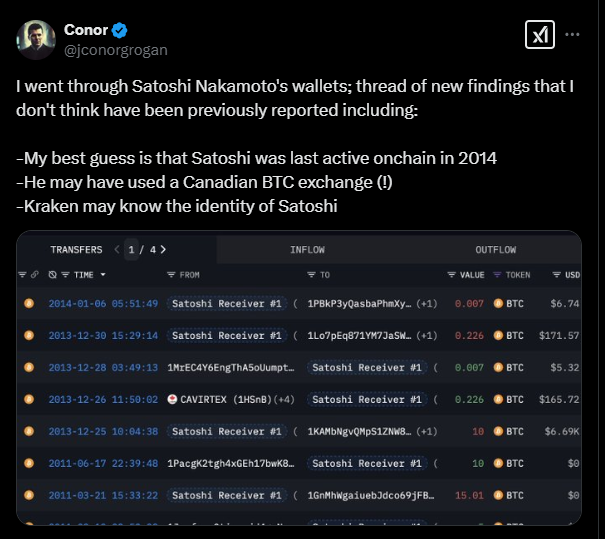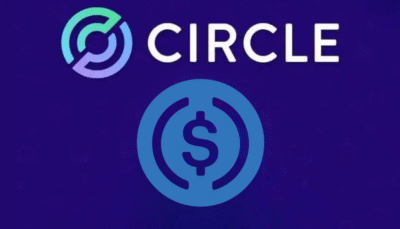Quick Facts:
- Coinbase executive Conor Grogan uncovered a new link between early BTC mining and a Canadian exchange later acquired by Kraken.
- Grogan’s research estimates Satoshi Nakamoto may control around 1.096 million BTC, worth over $108 billion.
- A Bitcoin address labeled “1PYYj” transacted with this exchange, sparking speculation that Kraken might have historical records tied to Satoshi.
- Despite years of investigation, the true identity of Bitcoin’s creator remains unknown.
The mystery of Satoshi Nakamoto’s identity has taken another interesting twist after Coinbase executive Conor Grogan uncovered a potential connection between early Bitcoin mining activities and a Canadian crypto exchange later acquired by Kraken. The discovery has sparked fresh speculation over whether Kraken holds key information about Bitcoin’s elusive creator.
Grogan’s analysis focused on Bitcoin addresses exhibiting the “Patoshi Mining Pattern,” a well-documented mining signature believed to be linked to Satoshi Nakamoto during Bitcoin’s earliest days. His research estimates that Satoshi may control approximately 1.096 million BTC, currently valued at over $108 billion.

However, the most intriguing revelation comes from transactional links between these early-mined Bitcoins and an address labeled “1PYYj,” which later interacted with a Canadian crypto exchange. This exchange, which was acquired by Kraken, now stands as a potential source of critical information about Bitcoin’s founder.
Was Satoshi Active Until 2014? New Wallet Activity Raises Questions
Grogan’s research not only traced Bitcoin’s earliest mining activity but also unearthed a potentially game-changing revelation—evidence that Satoshi Nakamoto may have remained active on-chain until as late as 2014. This finding challenges the long-held belief that Bitcoin’s mysterious creator vanished completely after 2011.
Satoshi’s final known public communication was an email to developer Mike Hearn in April 2011, where he stated, “I’ve moved on to other things. It’s in good hands with Gavin and everyone.” This message marked what many assumed was his official departure from Bitcoin’s development.
The new wallet activity suggests that Nakamoto may not have disappeared entirely, but instead chose to operate discreetly for several more years. While some believe that Satoshi’s departure was a strategic move to preserve Bitcoin’s decentralization, others speculate that he may have faced external pressures, legal concerns, or even personal circumstances that forced him into the shadows. There are also theories that Satoshi may have passed away, leaving his vast Bitcoin fortune untouched.
If Grogan’s findings are accurate, the idea that Satoshi remained an observer, or even an active participant in Bitcoin’s ecosystem for years, could fundamentally reshape the narrative surrounding Bitcoin’s early days.
Could Kraken Hold the Key to Satoshi’s Identity?
The connection has reignited theories that the true identity of Bitcoin’s creator could be buried in old exchange data. If early Satoshi-mined BTC was moved to an exchange, there’s a possibility that KYC (Know Your Customer) records or other transaction metadata from the now Kraken-owned platform could contain identifiable information.
“CaVirtEx was purchased by Kraken in 2016. As such. There is a chance that Jesse Powell has information on the true identity behind Satoshi, if they maintained any KYC information on this wallet. My advice to him would be to delete the data” – Grogan said.
While the crypto industry has long debated the ethical implications of unmasking Satoshi, the latest findings add a new layer to an already complex puzzle. Despite numerous theories, investigations, and claims, the identity of Bitcoin’s creator remains one of the most enduring mysteries in financial history.





